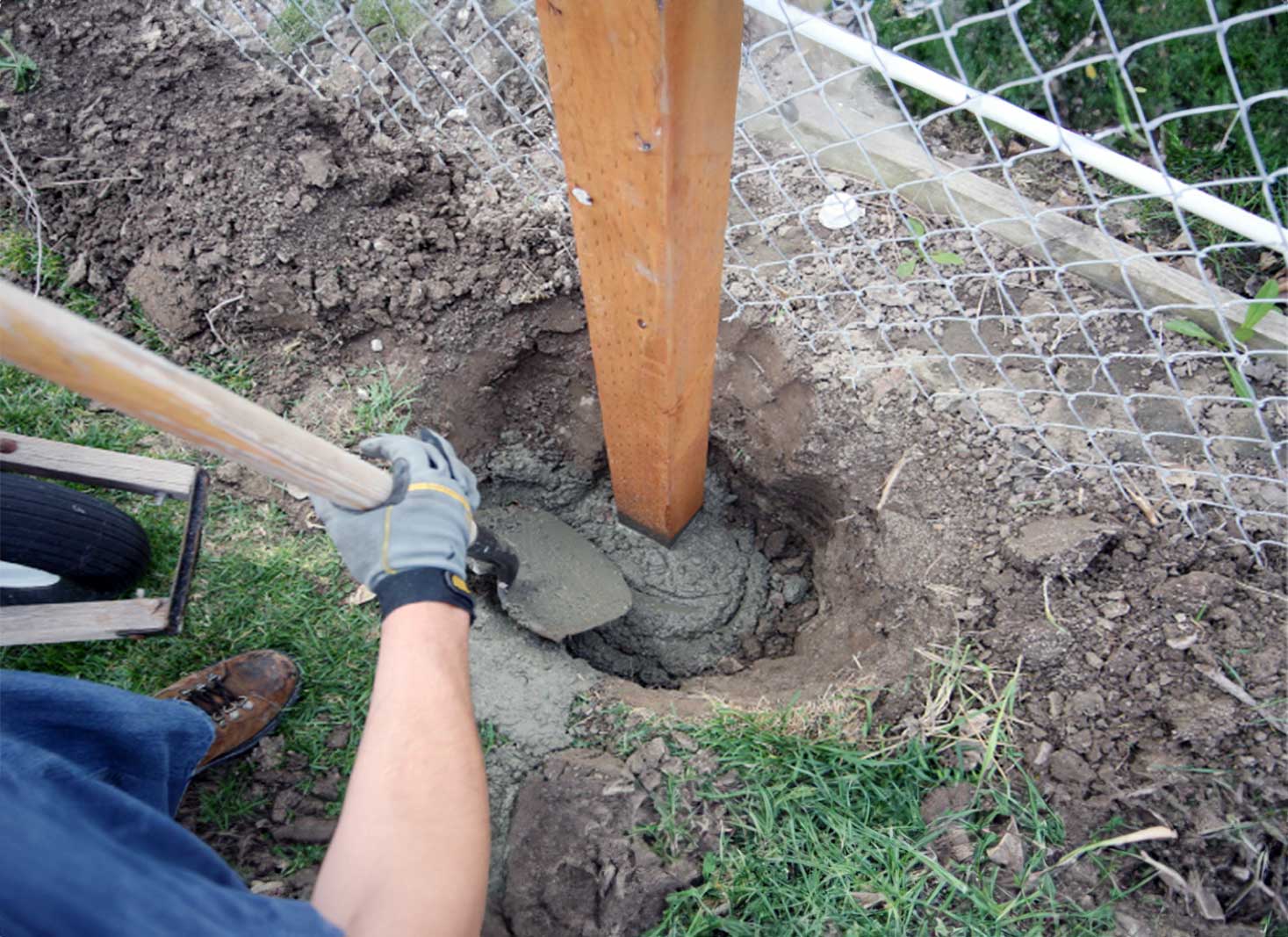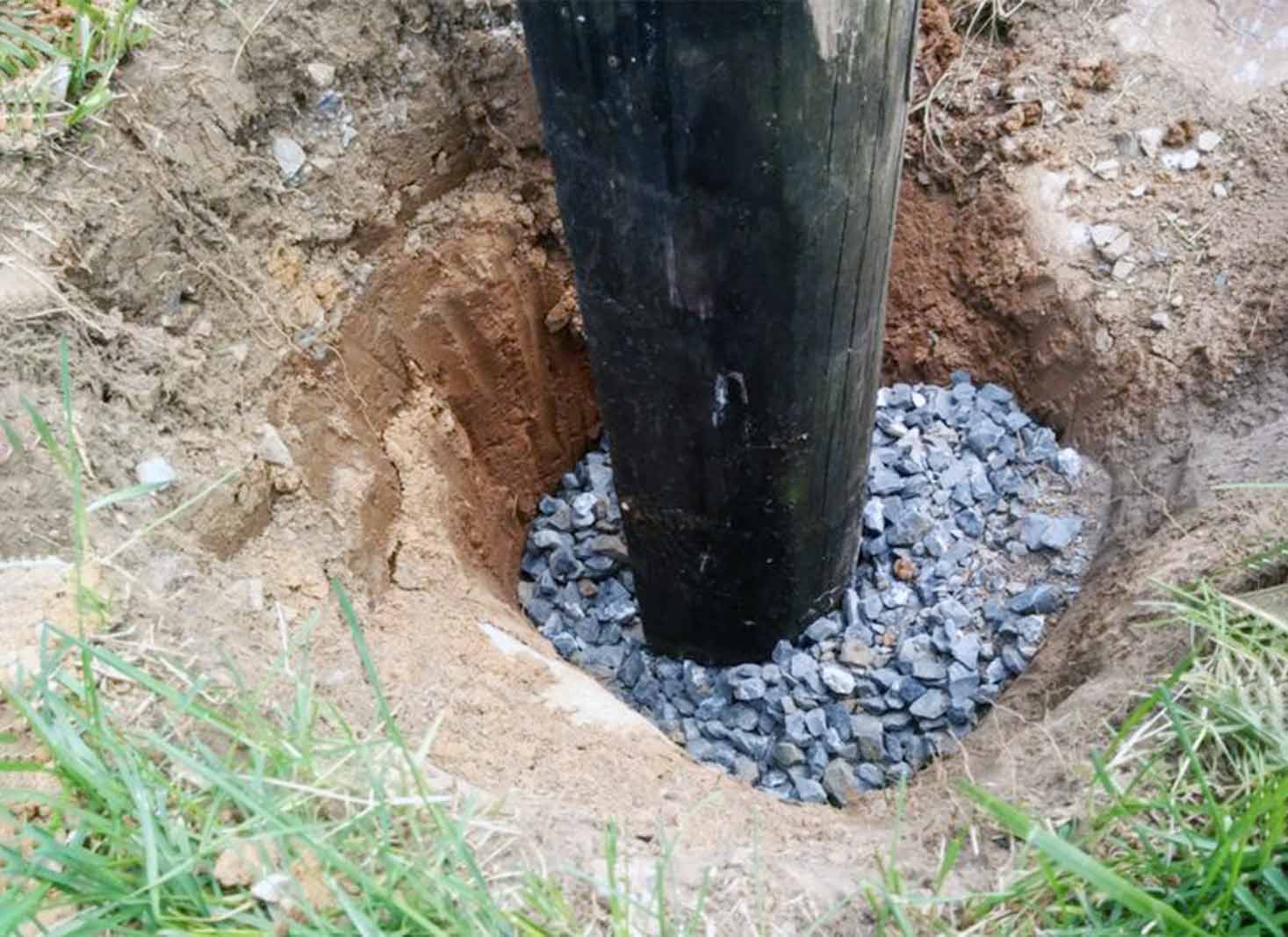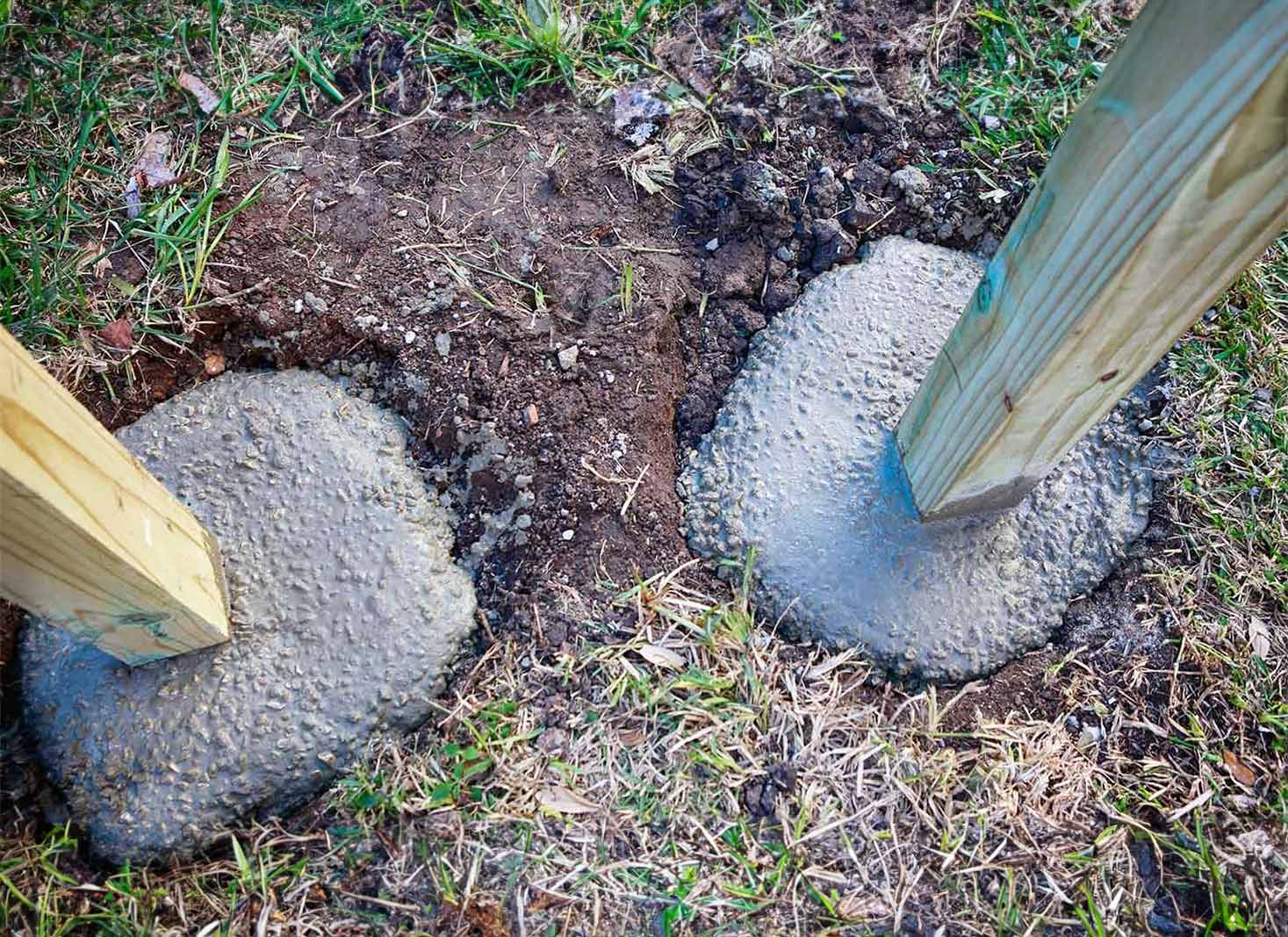Many people opt for wooden poles when they want to enhance the privacy and security of their homes. However, there’s a common concern about whether embedding these poles in concrete may lead to their deterioration.
While it is true that wooden fence posts can rot when set in concrete, there are steps that can be taken to prevent this. One of the causes of rot is moisture, which can seep into the wood and cause it to decay.
This is why it is important to choose the right type of wood and to use pressure-treated lumber, which is resistant to rot and decay.

What we cover
ToggleUnderstanding wood rot
Wood rot is a natural process that occurs when wood is exposed to moisture and air. It is a type of fungal decay that breaks down the wood fibers, causing it to weaken and eventually disintegrate.
Rot can occur in any type of wood, including treated wood, and it is a common problem for fence posts that are set in the ground.
Moisture
The primary cause of wood rot is moisture. When wood is exposed to moisture, it creates an ideal environment for fungi to grow and thrive. The fungi feed on the wood fibers, breaking them down and causing the wood to rot.
In addition to moisture, other factors that can contribute to wood rot include poor ventilation, high humidity, and warm temperatures.
Types of wood rot
There are several types of wood rot, including brown rot, white rot, and soft rot. Brown rot is the most common type of rot and is characterized by a brownish discoloration of the wood.
White rot, on the other hand, causes the wood to turn white or yellow and is less common than brown rot. Soft rot is a type of rot that only affects the outer layer of the wood and is usually caused by bacteria.
Preventing wood rot
Preventing wood rot is essential for preserving the life of your fence posts. One way to prevent rot is to use treated wood. Treated wood is wood that has been infused with chemicals that make it resistant to rot, insects, and decay.
Another way to prevent rot is to ensure that your fence posts are installed properly. This includes setting the posts in a concrete base that is above ground level to prevent water from pooling around the post.
Factors that contribute to wood rot in concrete

Wooden fence posts are commonly set in concrete to provide stability and support. However, over time, wood rot can occur, leading to weakened fence posts and the need for costly repairs or replacements.
Several factors can contribute to wood rot in concrete, including moisture levels, type of wood, and concrete quality.
Moisture levels
Moisture is one of the primary factors that contribute to wood rot in concrete. When wood is exposed to moisture for extended periods, it can lead to fungal growth, which causes the wood to decay.
The moisture levels in the concrete can also affect the wood’s moisture levels, which can accelerate the rotting process.
Type of wood
The type of wood used for fence posts can also affect the likelihood of wood rot in concrete. Some types of wood, such as cedar and redwood, are naturally resistant to decay and rot due to their natural oils and tannins.
Other types of wood, such as pine and spruce, are more susceptible to rot and decay and may require additional treatments or coatings to prevent rot in concrete.
Concrete quality
The quality of the concrete used to set fence posts can also affect the likelihood of wood rot. Concrete that is mixed with too much water can lead to excessive moisture levels, which can accelerate the rotting process.
Additionally, concrete that is not properly cured or is exposed to freeze-thaw cycles can crack and allow moisture to penetrate, leading to wood rot in concrete.
Homeowners and contractors should consider these factors when selecting materials and installing fence posts to ensure the longevity and stability of their fence.
Preventing wood rot in concrete fence posts

Wooden fence posts are a popular choice for many homeowners, but they can be prone to rotting when they come into contact with concrete.
This can cause serious damage to your fence and even compromise its structural integrity. Fortunately, there are ways to prevent wood rot in concrete fence posts.
Use of treated wood
One of the most effective ways to prevent wood rot in concrete fence posts is to use treated wood. Pressure-treated wood is pre-treated with preservatives that help resist the rot caused by moisture and other elements.
Alternative options to pressure-treated lumber are Western red cedar, white cedar or black locust, cypress or redwood. These types of woods are naturally resistant to rot and decay, making them a great option for fence posts.
Proper installation techniques
Proper installation techniques can also help prevent wood rot in concrete fence posts. When installing a fence post, it’s important to ensure that it is properly anchored in the ground.
This can be done by digging a hole that is deep enough to accommodate the post and filling it with gravel or crushed stone. This will allow for proper drainage and prevent water from pooling around the post.
Another important factor is to ensure that the post is not in direct contact with the concrete. This can be done by placing a piece of plastic or rubber between the post and the concrete.
This will help prevent moisture from seeping into the post and causing rot.
Regular maintenance
Regular maintenance is also important in preventing wood rot in concrete fence posts. This includes inspecting the posts on a regular basis and looking for signs of rot or decay.
If any damage is found, it should be repaired immediately to prevent further damage.
Additionally, the fence should be cleaned and sealed on a regular basis. This will help prevent moisture from seeping into the wood and causing rot. Sealing the wood will also help protect it from the elements and prolong its lifespan.
By using treated wood, proper installation techniques, and regular maintenance, you can help prevent rot and decay and enjoy your fence for years to come.
Signs of rot in wooden fence posts

Wooden fence posts that are installed in concrete can be prone to rotting. Rotting is caused by exposure to moisture, fungi, and insects. The following are some signs that wooden fence posts are rotting:
- Discoloration: The wood may appear darker or lighter than normal, or it may have black or green spots.
- Softness: The wood may feel soft or spongy to the touch, and it may be easy to push a screwdriver or other tool into it.
- Cracks or splits: The wood may have cracks or splits that are visible on the surface, or it may be splitting apart.
- Mushrooms or fungi: Mushrooms or fungi may be growing on or around the base of the fence post.
- Insect infestation: Termites, carpenter ants, or other insects may be present in the wood, or there may be visible holes or tunnels in the wood.
If any of these signs are present, it is likely that the wooden fence post is rotting and needs to be replaced.
Rotting fence posts can compromise the structural integrity of the fence and make it more vulnerable to damage from wind, rain, and other elements.
Preventive measures such as using pressure-treated wood, applying a protective coating, and ensuring proper drainage can help prevent rotting.
However, if rotting has already occurred, it is important to take action as soon as possible to avoid further damage.
How to replace rotted fence posts

Wooden fence posts can rot over time, especially when they are anchored in concrete.
If you notice that one or more of your fence posts are rotten, it’s important to replace them as soon as possible to prevent further damage to your fence.
Here are the steps to replace rotted fence posts:
Remove the old post: Start by removing the old fence post. If the post is anchored in concrete, you may need to dig around it to loosen it. Once the post is loose, remove it from the ground.
If the post is not anchored in concrete, you may be able to simply pull it out of the ground.
Prepare the hole: Once the old post is removed, you’ll need to prepare the hole for the new post. If the hole is filled with concrete, you may need to dig it out to create a new hole.
Make sure the hole is deep enough to support the new post.
Install the new post: Place the new post in the hole and make sure it is level. You may need to use a level to ensure that the post is straight. Once the post is level, fill the hole with concrete and allow it to dry.
Attach the fence: Once the concrete has dried, you can attach the fence to the new post. Make sure the fence is level and secure.
It’s important to note that if your fence posts are rotting due to being anchored in concrete, you may want to consider using a different anchoring method in the future.
For example, you could use metal fence posts or use a different type of concrete mix that is less likely to cause rot.
Replacing rotted fence posts is a simple process that can help extend the life of your fence. By following these steps, you can ensure that your fence remains secure and functional for years to come.
FAQ's
There are several effective ways to protect wooden fence posts from rotting when set in concrete. One way is to use pressure-treated wood, which is specially treated to resist rot and decay.
Another way is to use a wood preservative, which can be applied to the wood before it is set in concrete. Additionally, creating a drainage system around the base of the post can help prevent water from collecting and causing rot.
While setting fence posts in concrete is a common method, it is not the only way to prevent rot.
Other methods include using gravel or crushed stone to create a drainage layer at the base of the post, using post anchors that elevate the post above the ground, or using composite materials instead of wood.
The best type of wood preservative to use for fence posts will depend on several factors, including the type of wood being used and the climate in which the fence is located.
Copper naphthenate and creosote are both effective preservatives that can be applied to the wood before it is set in concrete.
The lifespan of wooden fence posts when set in concrete can vary depending on several factors, including the type of wood used, the quality of the concrete, and the climate in which the fence is located.
Generally, pressure-treated wood can last up to 40 years when properly maintained, while untreated wood may only last 10-15 years.
Some alternative materials or methods to use instead of concrete to prevent fence post rot include using post anchors, which elevate the post above the ground, or using composite materials instead of wood.
Additionally, creating a drainage layer at the base of the post using gravel or crushed stone can help prevent water from collecting and causing rot.
There are several types of paint or coatings that can be used to protect fence posts from decay when set in concrete. Oil-based paints or stains can provide a protective layer that helps prevent water from penetrating the wood.
Additionally, epoxy coatings or sealants can be applied to the wood before it is set in concrete to provide an extra layer of protection.







